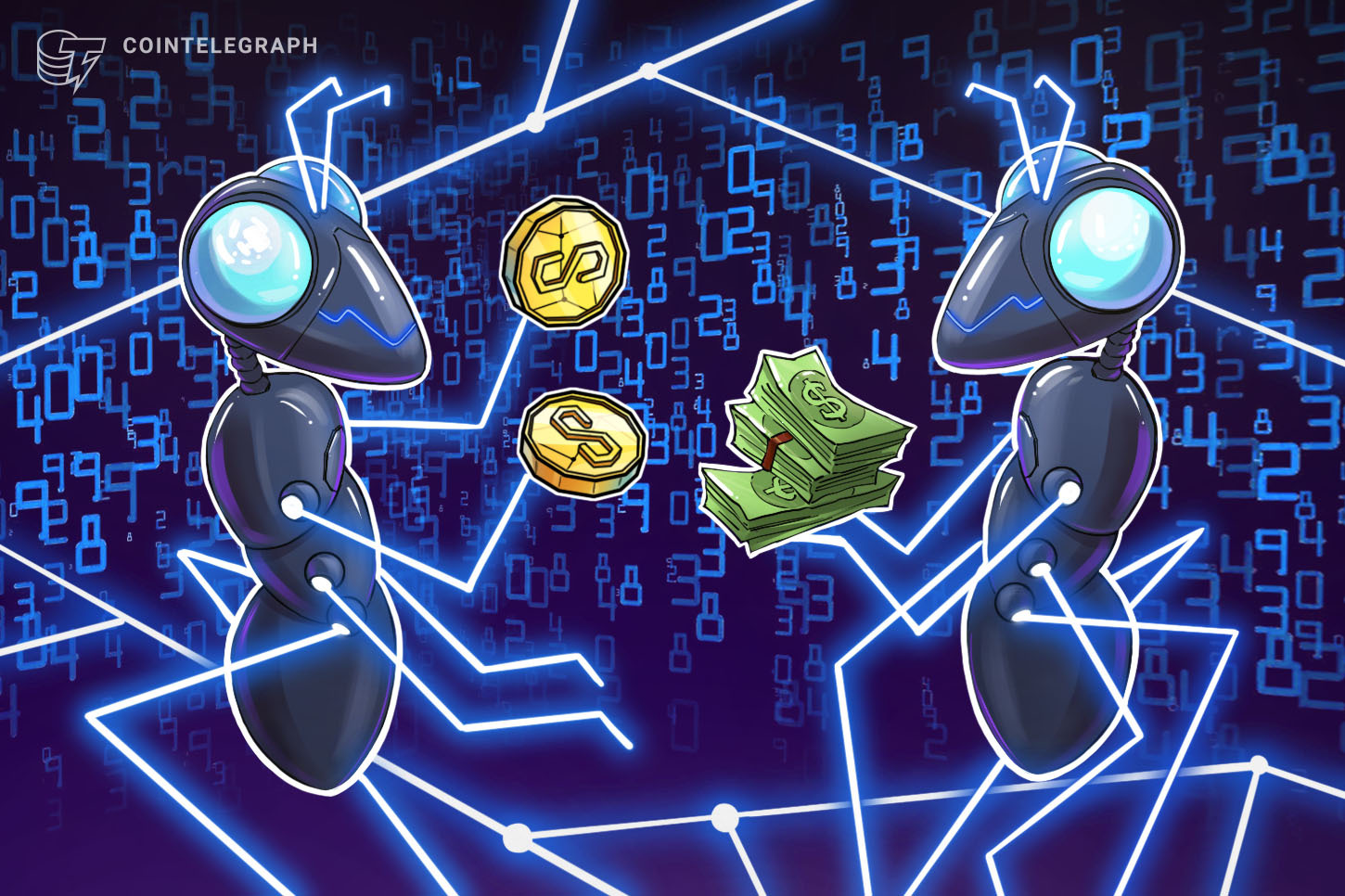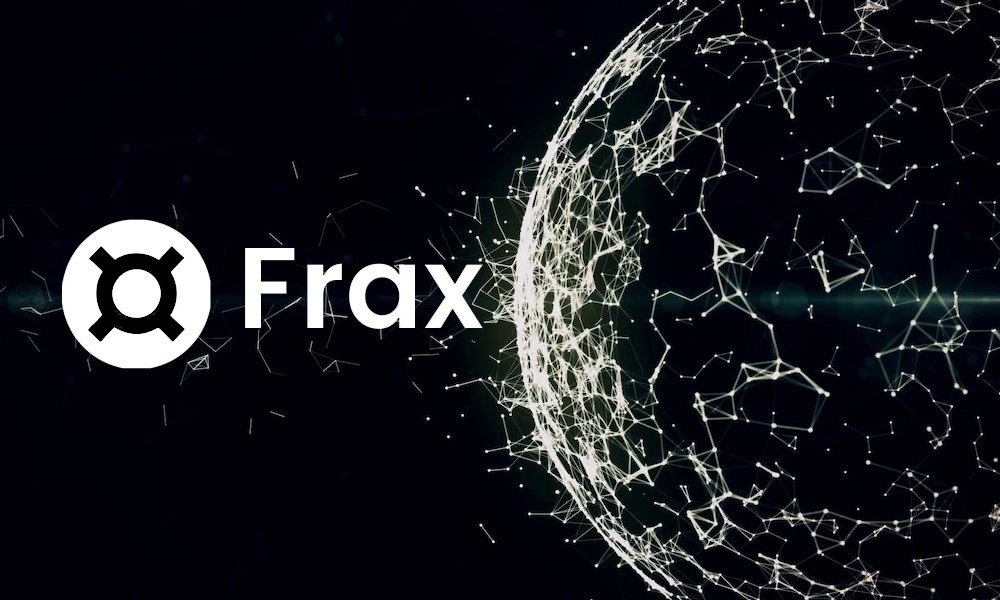The Frax token (FRAX), a crypto-collateralized stablecoin pegged to the U.S. dollar, and its staked version, sFRAX, will become native to the Cosmos ecosystem via Noble.
FXS Price Poised For Uptrend As Frax Finance Unveils Roadmap To Reach $100B TVL
Frax Finance, a decentralized finance (DeFi) protocol, recently unveiled its Singularity Roadmap. It aims to propel the total value locked (TVL) of its layer 2 blockchain, Fraxtal, to $100 billion by the end of 2026. This notable surge would represent a 760,000% increase from the current TVL levels, which stand at $13 million.
Frax Finance Singularity Roadmap
According to the protocol’s announcement, Fraxtal, the substrate that powers the Frax ecosystem, serves as Frax Finance’s operating system. With the launch of Fraxtal and achieving an effective 100% Collateralization Ratio (CR), Frax Finance claims to have consolidated its core product offerings.
To reach the ambitious $100 billion TVL goal, the protocol has announced that it has already generated over $45 million, reaching the coveted 100% CR.
As announced, with this milestone achieved, the FRAX stablecoin, which has remained relatively dormant during the process, and the FXS revenue share, which has been temporarily reduced by 90% to conserve assets, can now undergo a “transformative change.”
In addition, the upcoming introduction of Layer 3s (L3s) on Fraxtal is expected to be a key factor in further contributing to the growth and adoption of the protocol.
Fraxtal, which is built on the Optimism (OP) network, stands out as one of the most widely used layer 2 solutions on top of Ethereum (ETH), according to the protocol. The Frax team says it has developed its underlying incentives to provide a seamless experience for developers and users, further encouraging adoption.
In particular, by owning the entire stack, Frax can introduce advanced features such as account abstraction, new precompiles, privacy features, aggregated decentralized applications (dApps), and interoperability with Superchain.
The protocol believes these features will enhance the on-chain experience, making Fraxtal the “preferred” platform for holding, staking, and transferring crypto assets.
Expansion Strategy
The proposal also unveils Frax Finance’s plan to establish 23 Layer 3s within 365 days, kicking off the “Fraxtal Nation” community. By supporting these 23 chains with developer access, incentives, and investment, Frax aims to foster a positive-sum approach and provide additional support to official partners.
The protocol also suggests that these partners will receive “substantial allocations” of FXTL points, aiming to solidify the role of the FXS token as the ultimate beneficiary of the Frax ecosystem.
Moreover, Frax Finance founder Sam Kazemian intends to allocate 50% of the revenue from protocol fees to veFXS token holders. In comparison, the remaining 50% will be used to acquire FXS and other Frax assets for pairing in the FXS Liquidity Engine (FLE).
This initiative will increase liquidity, strengthen the Frax balance sheet, and provide additional incentives for the protocol’s stakeholders.
Frax Finance’s proposal also seeks to reactivate the protocol fee switch, which was temporarily turned off during the consolidation phase of the protocol.
By reigniting this switch, a portion of the yield generated from protocol fees will be directed toward veFXS token holders. veFXS, or veiled FXS, represents a locked version of the native token, FXS, and offers enhanced voting power and participation in the Frax ecosystem.
As of the time of writing, FXS has not responded favorably to the news. Its current trading price is $6.93, reflecting a 3.5% loss in the past 24 hours. It is important to note that the proposed protocol features are still in development, and the impact on the Frax Finance ecosystem and the token’s performance is yet to be determined.
Featured image from Shutterstock, chart from TradingView.com
Frax Finance Targets $100B Value Locked in Singularity Roadmap
Frax’s singularity roadmap has set a target of $100 billion in TVL for its layer 2 Fraxtal.
Frax Finance Mulls Uniswap-Like Reward Mechanism for Token Stakers
“We are going to follow Uniswap’s lead in proposing it. It will be up to the community to pass it,” Frax’s CEO Sam Kazemian told CoinDesk.
Frax Finance’s Layer 2 Fraxtal to Debut in February: Founder
Kazemian expects Fraxtal to debut with a bang, attracting at least several hundred million dollars worth of crypto assets in the first month.
PayPal’s Stablecoin Part of Third Largest Liquidity Pool on Curve
Curve’s FRAXPYUSD liquidity pool, which went live on Dec. 27, boasts the third largest TVL of $135 million.
Frax Finance Says its Domain Name Hijacking Has Been Resolved
Frax founder Sam Kazemian says his team has been “left in the dark” by the domain registrar as to what happened.
Michael Egorov’s $100 Million Position, A Risk To Curve Finance And DeFi?
Following the recent exploit of Curve Finance pools, there have been genuine concerns about the stability of the decentralized exchange and the Decentralized Finance (DeFi) ecosystem. A new report has emerged, raising questions about Curve founder Michael Egorov’s $100 million loan positions.
These positions have garnered significant interest, as they are backed by about 47% of the entire CRV circulating supply. With the price of CRV dwindling, these debts appear to be at risk of liquidation, putting the Curve protocol, CRV investors, and the overall DeFi space on edge.
A Breakdown Of Michael Egorov’s $100 Million Loan
On Tuesday, August 1, crypto research firm Delphi Digital released a series of tweets, detailing the loan positions being held by Michael Egorov. According to the report, the Curve Finance founder has around $100 million in loans across various lending protocols backed by 427.5 million CRV tokens.
Egorov has a 63.2 million USDT loan backed by 305 million CRV tokens on Aave. Delphi Digital revealed that the position has a liquidation threshold of 55% and is eligible for liquidation at 0.3767 CRV/USDT.
For context, the CRV currently trades at $0.608595, according to CoinGecko data. This means that a 38% price decline will cause a liquidation of Egorov’s position on the Aave protocol.
Meanwhile, the Curve founder has 59 million CRV backing a loan of 15.8 million FRAX on Frax Finance. Although this debt is much lower than his Aave position, it poses a much more significant risk to CRV due to Fraxlend’s Time-Weighted Variable Interest Rate.
Delphi Digital also noted that liquidation of the Frax loan position can occur regardless of CRV’s price. According to the research firm, the loan is currently at 100% utilization, which allows the interest rate to double every 12 hours.
While the interest rate currently stands at 81.20%, Delphi Digital said that it can potentially increase to the maximum of about 10,000% APY in 3.5 days. This high-interest rate could result in the eventual liquidation of the debt.
How Has The Curve Finance Founder Responded?
So far, Michael Egorov has tried to stabilize his positions and the utilization rate twice, repaying a total of 4 million FRAX on July 31st. However, the utilization rate remained at 100%, as users swiftly remove liquidity as soon as he makes the payment.
To address this, the Curve founder deployed a new Curve pool on Tuesday, August 1. This pool consists of stablecoin crvUSD and Fraxlend’s CRV/FRAX LP token, seeded with 100,000 CRV rewards.
This is to incentivize liquidity toward the lending market, decrease the utilization rates, and ultimately reduce the liquidation risks.
According to Delphi Digital, this pool attracted $2 million in liquidity and lowered the utilization rate to 89% four hours after launch.
Ethereum DeFi Coins Plunge As Curve Concerns Threaten Major Market Crash
The Ethereum DeFi space is currently experiencing a rough few hours. All major DeFi coins are posting deep red numbers in the last 24 hours: Compound (-18%), Aave (-10%), Curve (-10%), Frax (-6%), and Synthetix (-6%).
The reason? Curve Finance, a flagship decentralized exchange specializing in stablecoin swaps, recently suffered a significant exploit. The resulting aftershocks are being felt across the DeFi ecosystem, inciting fears of a broader Ethereum DeFi massacre. The exploit, causing a damage of around $100 million, sets off potential domino effects threatening the stability of the wider DeFi landscape.
Curve Hack Sparks Fears Of Ethereum DeFi Crash
Delving into the details of the exploit reveals the intricate dynamics at play. The attackers took advantage of vulnerabilities in the Vyper smart contract software, leading to the significant losses on Curve Finance. The repercussions of this incident have been profound. The popular stablecoin DEX Curve Finance could be a ticking time bomb for the rest of the Ethereum DeFi sector.
Post-incident, it is reported that over $45 million has been drained from liquidity pools of third-party providers, with an additional $25 million directly siphoned from the Curve Protocol’s CRV/ETH pool. The ensuing liquidity crisis and the impending risk of further sell-offs, given the millions of Curve (CRV) tokens still held by the attackers, is generating substantial anxiety within the market.
The founder of Curve Finance, Michael Egorov, has not been immune to these significant losses. His large positions backed by CRV have come under intense pressure, pushing the platform to the brink. Delphi Digital explains, “Curve founder, Michael Egorov, currently has a ~$100 million loan backed by 427.5 million CRV (about 47% of the entire CRV circulating supply). With CRV down 10% over the past 24 hours, the health of Curve is in jeopardy.”
Furthermore, Egorov holds large loans on Aave and Frax Finance, backed by CRV collateral. On Aave, he has a $305 million CRV backed loan amounting to 63.2 million USDT. At a liquidation threshold of 55%, his position could be liquidated if CRV/USDT hits $0.3767. As per Delphi Digital’s assessment, this would require a ~33% drop in the CRV price. Egorov also carries a ~4% APY for this loan.
The situation on Frax Finance is even more precarious. Here, Egorov has supplied 59 million CRV against 15.8 million FRAX of debt. The high utilization and the Time-Weighted Variable Interest Rate, doubling every 12 hours, makes his position particularly vulnerable to astronomical interest rates and subsequent liquidation, irrespective of the CRV price.
Delphi Digital emphasizes, “This astronomical interest rate could lead to his eventual liquidation, regardless of CRV price. At a max LTV of 75%, his position’s liquidation price could reach 0.517 CRV/FRAX within 4.5 days, less than a 10% decrease from current prices.”
Today, Egorov deployed a new Curve pool and gauge: a 2 pool consisting of crvUSD & Fraxlend’s CRV/FRAX LP token, seeded with 100,000 of CRV rewards. However, with no success. Utilization was quickly back to 100% as illiquid CRV holders took Frax stables to exit, and Frax lenders bailed on risky pool. Thus, Egorov’s new pool is just spending more of his CRV and not bringing his interest rate down.
As the market grapples with the mounting liquidation risk of Egorov’s positions, the potential market-wide repercussions are alarming. Autism Capital warns, “If Michael gets liquidated by Fraxlend, all of his other debt positions will be liquidated too. This likely means Inverse Finance (INV) and Magic Internet Money (MIM) will both die due to the new bad debt, and Aave will get stuck with $63 million of bad debt.” Moreover, a liquidation of Egorov will likely trigger cascades on-chain and nuke CRV to almost zero.
Not All Hope Is Lost
However, despite the ensuing chaos, the DeFi sector’s operations, strictly governed by code and math, remain unaffected. As Autism Capital rightly puts it, “In one sense, this is proof that DeFi works as intended. There are no special rules or bailouts, no matter who you are. It’s a brutal free market governed by math and code.”
Moreover, there’s still hope for a happy-end. Assuming liquidity recovers, the DeFi sector might regain balance. The Curve team has indicated that several millions in US dollars are in possession of white-hat hackers. This could potentially enable the recovery of some of the misappropriated assets. Additionally, some bots intercepted a significant quantity of CRV tokens from the Curve attackers.
Nevertheless, the threat of the situation spreading remains a serious concern. Platforms like Frax, Aave and others remain on high alert, while some, like Alchemix, have already halted their smart contracts.
[UPDATE]
It looks like Egorov got an OTC deal with a CEX, paying off his debt. This is the reason for CRV’s price rebound.
About to drop to $13M loaned.
The money is definitely coming from an OTC deal.
It looks like a handshake deal. He’s selling his CRV at 0.4
2.5M crv for 1M usdt clips
Which one of you chads got the sick deal? I assume this will go until entire debt paid off. pic.twitter.com/3c5OmcQ7wH
— Midas: Fool’s Gold (@MidasFoolsGold) August 1, 2023
At press time, the Curve (CRV) price saw a slight recovery within the last three hours, rising to $0.57.
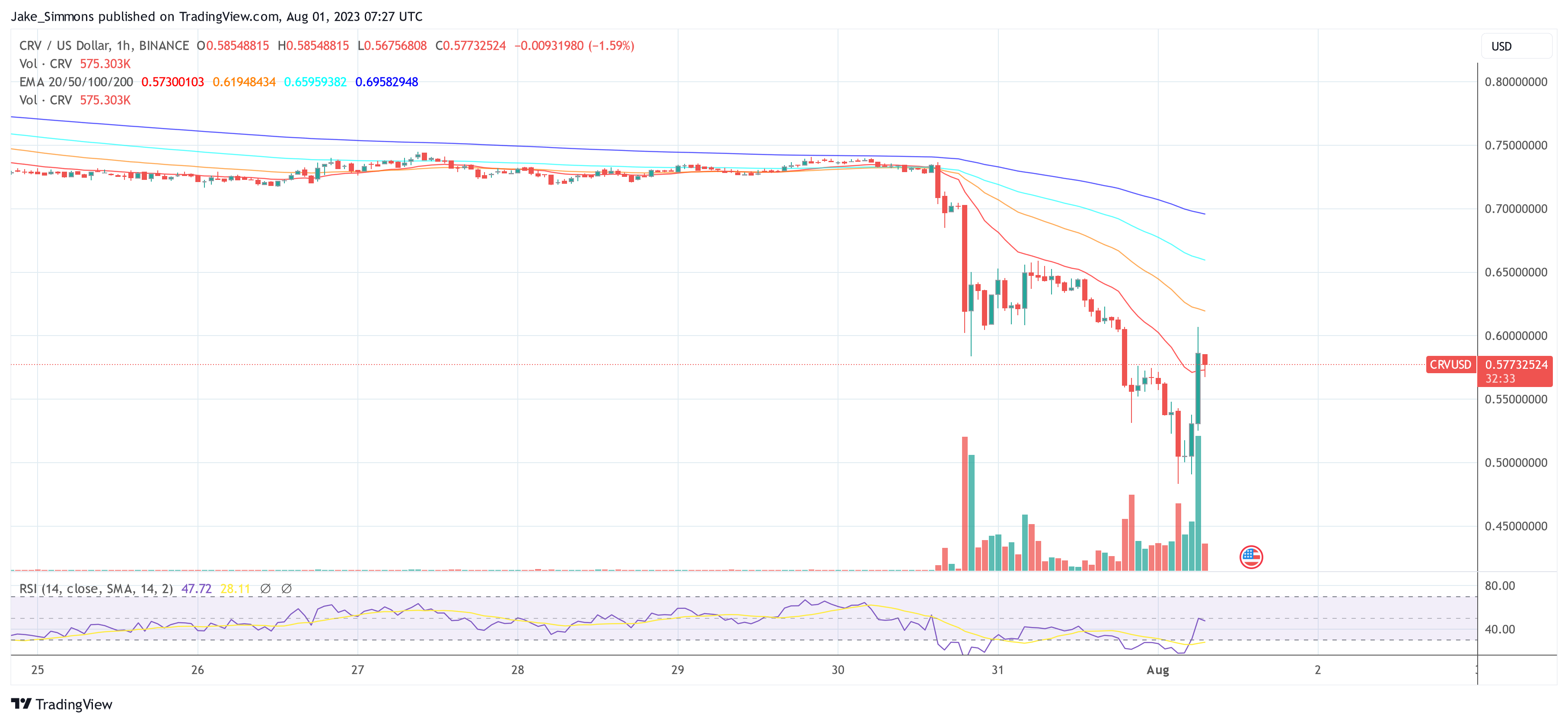
Frax Finance to retire algorithmic backing amid stablecoin crackdown

The vote was passed to fully collateralize Frax Finance’s native stablecoin, thus phasing out its algorithmic backing.
Ethereum-Based Frax Finance (FXS) Is Up 64%, Is There Still Opportunity?
In the last seven days, the Ethereum-based project Frax Finance is the second biggest winner within the top 100 cryptocurrencies by market cap. With a price increase of 64%, the FXS token is only behind Decentraland (MANA), which has surged 76% within the same period.
With the massive pump, Frax Share Token (FXS) has moved up to the 63rd position in the ranking by market cap and has seen a bullish rally since January 2. While the price was $4.09 on that day, FXS was at $9.06 at press time.
When the price briefly rose above $10 yesterday, the gain was over 140% since January 2. In the 1-day chart, FXS has broken the resistance zone established in May last year between $7.40 and $8.20 and is now facing resistance at $10.02.
The first two attempts to break this resistance have failed for now, so a retest of the former resistance zone could be on the cards before the Frax token continues to rally. This would also be a much-needed correction, as the RSI on the daily chart is still at 83.
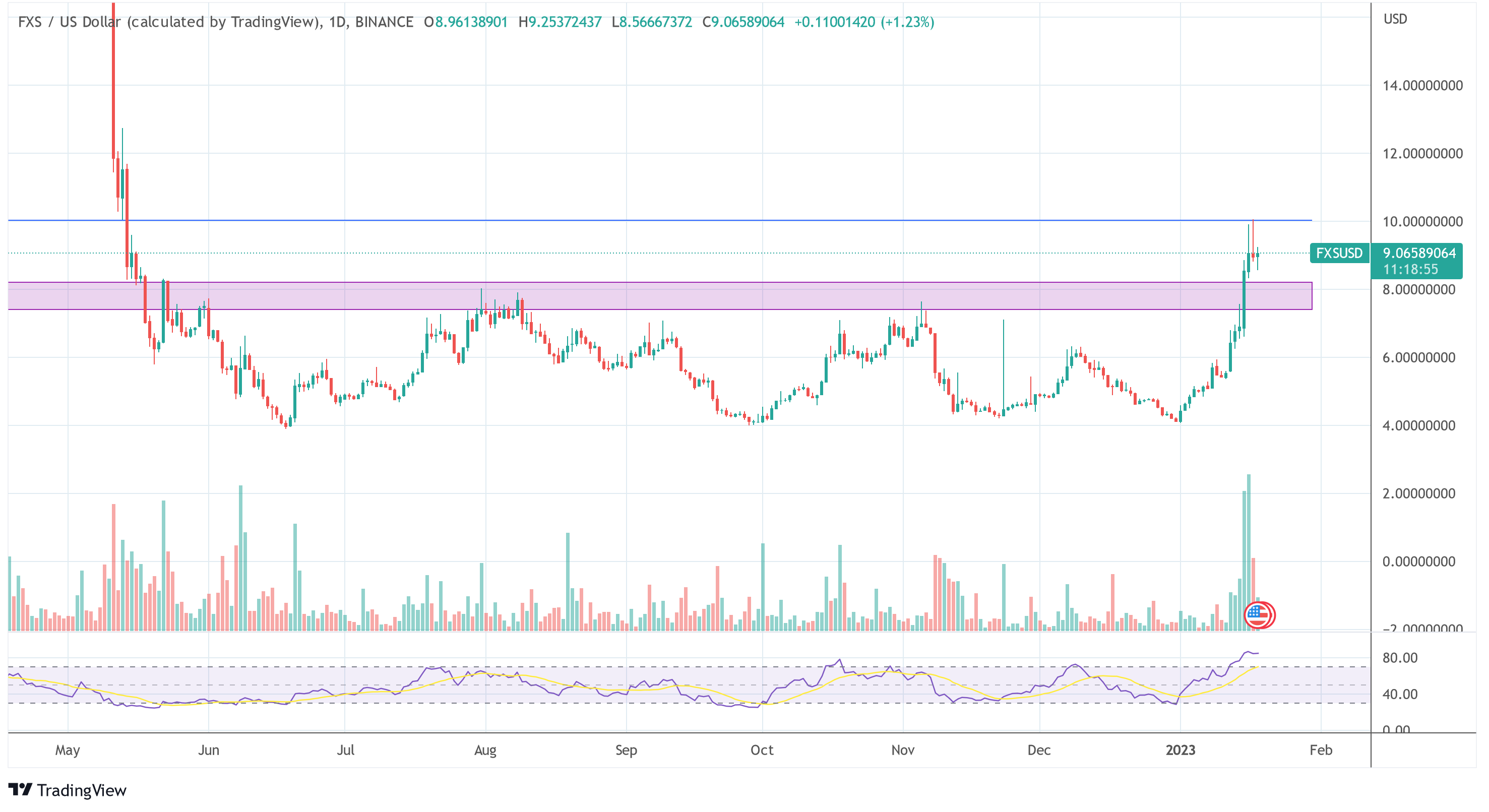
The weekly chart confirms the extremely bullish picture for the FXS token. Once the price consolidates in the daily chart and subsequently breaks the $10.02 level, the way would be clear for a rise toward $13.
The price level served as strong support in November and December 2021, before FXS rallied to an all-time high of $52.80 in January 2022.
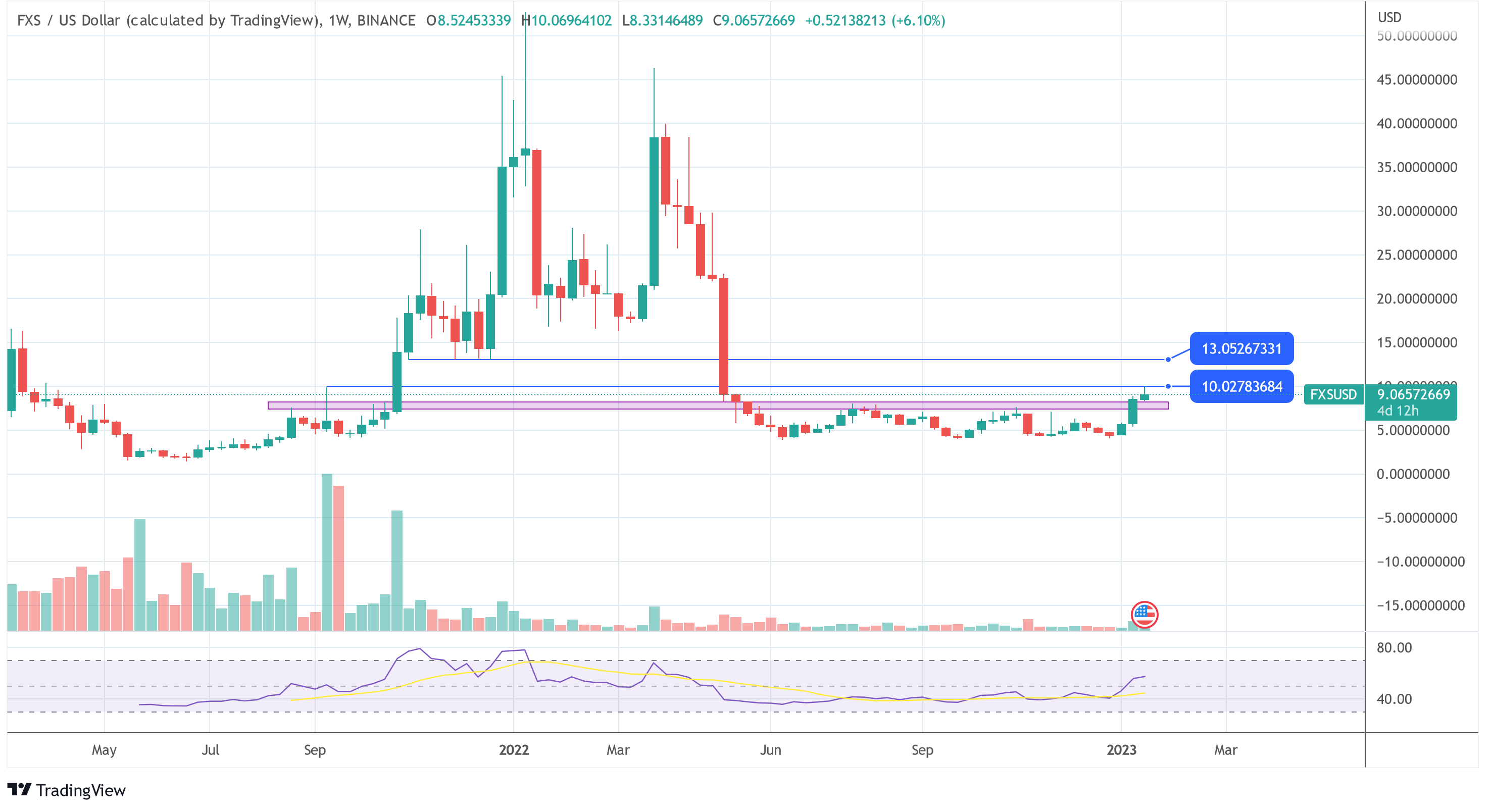
What Do The Fundamentals Of Frax (FXS) Suggest?
As NewsBTC reported, Frax Finance is benefiting from the liquid staking (LSD) narrative that emerged earlier this year and has since caused all LSD tokens to skyrocket. However, it is questionable whether the hype can continue for a longer period of time.
As Jordi Alexander, CIO of Selini Capital explained, the Ethereum Shanghai hard fork could be in for a rude awakening:
ETH staking is going to explode after the Shanghai fork allows withdrawals- esp. now as Metamask integration makes it easy for Dummies. But LSD tokens are overvalued in anticipation of this – revenue is not going to change much, bc reward yields will plunge as staking % goes up.
But analyst Thor Hartvigsen doubts whether the same will be true for Frax Finance. The analyst shared five reasons via Twitter why Frax Finance will be a key player in DeFi this year.
The first reason is that Frax offers the largest APR among liquid staking providers at 6-10%, while its nearest competitor is only around 5%. The main reason for this difference is that frxETH can be used in DeFi applications such as the ETH/frxETH Curve pool.
The second reason Hartvigsen cites is that Frax Finance has made extensive improvements since its inception, in particular, it has improved its model (FRAXV2) and “has become a huge liquidity engine with a range of products.”
These include algorithmic market operations (AMOs), FraxSwap, FraxLend, FraxFerry (native bridge design), ETH liquid staking, and FPI (US inflation rate linked stablecoin).
¤ Frax Finance has been crushing it lately
And with their growing ecosystem of DeFi products, $FXS has a TON of upside in 2023.
Here are 5 reasons why @fraxfinance will be a central player in DeFi this year and how you should be taking advantage of this
1/19 pic.twitter.com/epFMEgY4HF
— Thor Hartvigsen (@ThorHartvigsen) January 17, 2023
Third, it’s the AMOs that make Frax special, as they don’t just let collateral sit dormant, but use it in various DeFi applications. It also offers some of the highest stablecoin yields, which significantly strengthens FXS by increasing liquidity on Curve.
Last but not least, Hartvigsen points to Frax’s roadmap to reach a market cap in the trillions and become the risk-free underlying in DeFi. The analyst touts the Fed Master Account (FMA) as the biggest innovation:
A FMA is dollars deposited directly into the FED treasury’s ledger and grants access to US Treasuries. The FED gives a status on the ledger once a day which essentially is the ultimate audit.
This would make FRAX one of the closest things to a ‘risk free dollar’. It’s a very ambitious goal however and likely a few years away.
Featured image from Inside Out, Charts from TradingView.com
Stablecoin projects need collaboration, not competition: Frax founder

As long as stablecoin “liquidity is growing proportionally with each other,” there won’t ever be true competition between stablecoins, says Frax Finance’s Sam Kazemian.
